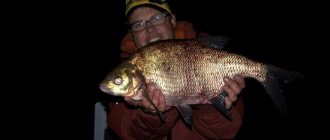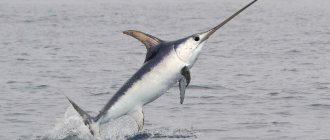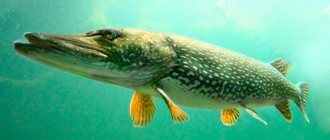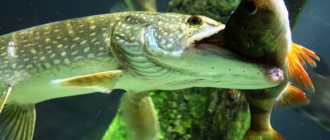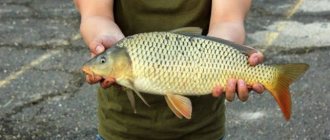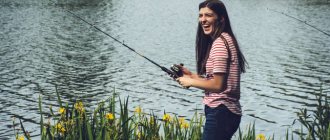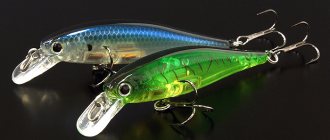A catfish of this size can easily swallow an adult, as evidenced by official data. Some experts claim that there are cannibal catfish. But such statements have no scientific evidence. If human corpses are found in the belly of a river giant, it is assumed that the people were already dead. Simply put, these people drowned in due time, and only after that they were swallowed by a catfish.
Nowadays, the number of large catfish has sharply decreased due to the difficult environmental situation, as well as uncontrolled human fishing. In addition, modern gear has enormous potential in terms of catching fish. Despite this, weighty underwater predators are still occasionally encountered. In order not to be unfounded, we can present to your attention an overview of the largest catfish in the world, caught not so long ago.
Kinds
There are several species of marinka, which differ in habitat and food preferences. They are capable of interbreeding with each other, and their young are also capable of bearing offspring. The common marinka is the most common species. It is about a meter long, weighing up to 2 kg. It feeds on both fry and algae. The river variety is light gray in color, while the lake variety is brighter. Distributed throughout Asia. The fish is omnivorous and prefers to stay at depth.
Illiyskaya
This is the largest species of fish presented. It is a little more than a meter long, but its weight can reach 12 kg. The main feature is a large head, disproportionate to the body. This can be clearly seen from the photo and learned from the description. Lives in the Ili River. It feeds only on aquatic animals. It is listed in the Red Book of Kazakhstan; the last catch was recorded in the 70s. At the moment, attempts are being made to restore the population through artificial breeding; fishing is prohibited.
Balkhash
Lives in Turkmenistan, in the salt water of Balkhash. It is not very large, about 40 cm in length. Differs in large scales. The main food is vegetation. This species is found exclusively in rivers; its numbers are small. There are river, lake-river and lake varieties. The meat of this type of fish is tastier than that of other species.
Pike-shaped
A predatory fish that feeds on small fish, crustaceans, and beetles. Reaches medium size in adulthood and likes to live in bottom layers with fast currents. Lives in Turkmenistan. Its parameters are very similar to the ordinary marinka fish, but it differs in the location of its mouth - it is capable of grabbing prey in any direction. She is characterized by cannibalism.
RED LIST FISHES
Let's start with the most valuable fish - those listed in the Red Book. Eight species of fish are included in the Red Book of the Republic of Uzbekistan. If you are objective and try to find out the reasons for the disappearance of this or that species, it turns out that “damned poachers” have nothing to do with it. The main problem is the consequences of ill-conceived human economic activity. Especially in our agricultural country, where water is the greatest value, since all agriculture is irrigated, and the soils are saline and require not only watering, but also leaching. Yes, and agricultural crops, mainly cultivated here (rice, cotton), require, figuratively speaking, that their “head” be in the sun, and their feet (sorry, roots) bathed in water. Because of this, the waters of two large Central Asian rivers—Amu Darya and Syr Darya—are almost completely diverted for irrigation. Hence the reasons for the tragedy of the Aral Sea - it simply dried up due to lack of replenishment with river water. Now the area of the water mirror of the former sea is only 10% of its current size, all freshwater (and sea) fish that lived in the sea have died out due to extremely high water salinity.
Migratory fish feeding in the sea were the first to suffer. the thorn, was unable to adapt to the new conditions and disappeared from the Amu Darya . The same fate befell a large representative of local salmonids - the Aral salmon . There are not even photographs left “for memory”; in ichthyological reference books you can only find color pictures.
Three sturgeon representatives lasted a little longer - the Syrdarya pseudoshovelnose , as well as the large and small Amu Darya pseudoshovelnose . These lovers of shallow depths, fast currents and sandy-pebbly bottoms were “knocked down” by flow regulation and the construction of reservoirs, leading to a slowdown in the flow and silting. False pathologists are endemic to Central Asia; a closely related species lives somewhere else in Missouri. Until the end of the 70s, there were rumors in the fishing community about the capture of strange fish with a bony, spade-shaped snout and a long awl-shaped tail in the Syr Darya, but recently such talk has died down.
The Amudarya pseudoshovel-noses are in a much better position, although they are also an endangered species. Last year, one of the local newspapers wrote that unknown well-wishers presented the Tashkent Zoo with two specimens of the large Amu Darya silverback, which made local ichthyologists very happy - it turned out that this seemingly extinct fish still exists! But if scientists had gotten out of the capital closer to the Amudarya, they would have discovered that these “strictly protected” rare fish not only exist, but are also caught in the catches of Amudarya poachers. So, in Karakalpakstan, where a fishing company I knew visited in search of a large asp in December last year, fishermen were offered to buy “sturgeon” for the New Year’s table - several frozen carcasses of these very relict pseudopathogens.
the Aral longhorned beetle is more or less lucky . Of course, its former place of residence - the Aral Sea - will no longer be restored, and the dams built on the rivers that interfere with the spawning run will not be destroyed, but the barbel has adapted to such conditions. At least in the western reservoirs associated with the Amu Darya, the Aral barbel is the most common species. He also retained the habit of traveling, however, to spawn he now does not go up the Amu Darya and Syr Darya, but enters the main irrigation canals. The permanent feeding area is the Amu Darya reservoirs and large steppe lakes. In the canals, fairly large Aral barbel (up to 5 kg) is caught along with the Turkestan one. There are several other small species of Red Book fish that are more natural monuments than objects of fishing interest - we will not mention them.
It is not difficult to determine the habitats of catfish; these are whirlpools and holes with washed-out banks, snags in reservoirs, places on rivers with high steep banks and reverse flows, near dams on large rivers. The catfish is a sedentary predator, choosing a hole or pool for itself and leaving from there to feed, it then returns to its hole again. Sometimes catfish enter the mouths of small rivers, noisily hunting for small fish.
The best baits for catching catfish are live bait, large leeches, and frogs. Various sources talk about fishing with fried sparrows, animal livers, meat, and even laundry soap - maybe these baits work, but not reliably. Large live bait is the most reliable bait that attracts catfish in any body of water. The size of the live bait is not important, the basic rule is that the live bait for catching catfish should not be too small, the optimal weight of the live bait for catching catfish is 100-200 grams, and for catching trophy specimens, live baits up to 800 grams are used. Since catfish are bottom-dwelling fish, it is more natural to use fish that live in the same horizon with the catfish for bait. Although asp and chub are considered the best live bait, being surface fish, they do not hide, but are in constant motion, attracting catfish from a great distance.
The gear for catching catfish is the simplest, it is best to use a donk, along with the main fishing line you can use a nylon cord, a metal leash is not necessary, a nylon cord or fishing line of the thickest diameter will be enough. Catfish are not sensitive to the thinness of the tackle, and when they take the bait, as a rule, they immediately swallow it. In order for the catfish to reliably hook and sit on the hook, you need to use high-quality durable hooks. It is interesting to catch catfish on a heavy feeder with strong braided fishing line.
The best time for catching catfish is in the evening until midnight; at sunset, this predator goes hunting. In gastronomic terms, catfish is excellent! Catfish has white, tender, fatty meat, with virtually no bones. There are many recipes for preparing catfish, but you should remember that catfish is not suitable for cooking fish soup; fried catfish is especially tasty. I will share a recipe for a simple and tasty catfish dish; this dish can even be prepared directly while fishing, from freshly caught fish. So, the recipe for fried catfish: To prepare this catfish dish you will need:
- Catfish (catfish meat, fillet can be cut) – 500 grams
- Vegetable oil (preferably refined) - 4 tablespoons
- Flour or semolina - 1 tablespoon
- Ground cloves or allspice, ground black pepper, salt - to taste
Clean the catfish, rinse and cut into fairly thick slices, then rub the fish with a mixture of salt and spices. Leave to marinate for half an hour. After this, roll in flour or semolina, then fry in sunflower oil until crispy. A delicious dish is ready! And please remember that the minimum size of catfish allowed for catching in Belarus is 70 centimeters, release small catfish, this is the only way you can count on catching worthy specimens in the future.
Marinka structure
The appearance of an inhabitant of fast currents immediately reveals that he is a strong, swift swimmer with an excellently developed sense of smell and a bottom-based type of feeding. Distinctive features of the marina fish's exterior include:
- muscular, elongated body of slightly oval cross-section;
- a strong sloping back of gray, dark brown or chestnut color (the color is influenced by the habitat);
- large olive green head;
- well developed two pairs of whiskers;
- downward-facing mouth with fleshy lips and a lunate lower jaw;
- pale silver, creamy yellow, bronze or grass-ash color of the sides;
- light belly;
- dense small scales covered with thick mucus;
- elongated caudal peduncle;
- orange iris;
- high triangular fin with a spine.
Marinka fish belongs to the class of six-rayed subfamily of split-bellied fish (Schizothoracinae), therefore it has a unique physiological feature (“split”), which is a fringing of large scales (15-29 pieces) around the anus.
The closest relatives of the genus (Schizothorax) are the Ottomans (Diptychus) or the pseudo-Ottomans (Schizopygopsis). The latter, due to their strong attachment to high-mountain rivers, received an additional official name - the Highlanders.
In turn, the popular nicknames of Marinka are associated with tender milky meat, silvery sides, a light belly - “akbalyk” (white) and a dark film covering the inner surface of the peritoneum - “karabalyk” (black) fish. In addition, the species has another common name - “sharmai” (from Kazakh “ball” - round, “may” - oil), which appeared due to its torpedo-shaped body and thick slippery mucus on the scales, facilitating rapid movement in rapids.
To learn more:
The many-faced asp: sheresper, grip and horse-fish
Lukashenko boasted that he caught a catfish weighing 57 kilograms
The catfish caught by the Belarusian president weighed almost 60 kilograms.
The President of Belarus caught three catfish in the Pripyat River, and one of the caught fish weighed 57 kilograms. The rest of the catfish turned out to be more modest - one weighing 24 kilograms and one weighing only seven.
Alexander Lukashenko spoke about his fishing success at a meeting where issues of improving hunting and fishing rules were discussed, writes interfax.by. According to the Belarusian president, order has been restored in Pripyat. “Now you stick your finger in there and a fish grabs your finger,” he boasted.
Lukashenko said that he caught a catfish weighing 57 kilograms
Mikhail Rusy, Deputy Prime Minister of the Belarusian government, noted that such a large catfish should be about his height.
“But not by weight!” - Alexander Lukashenko reacted.
The fish caught by the Belarusian president turned out to be almost three times larger than the 20-kilogram pike that Vladimir Putin caught on vacation in Tyva.
But this is the biggest pike that Vladimir Putin caught in his life!
BY THE WAY
In 2011, a Belarusian from the Stolin region accidentally caught a giant catfish
The giant catfish, which was caught by a simple Belarusian, weighed 51.5 kg! Not a presidential trophy, but good too!
Sergei Sen, a resident of the village of Belousha, Stolin district, caught the fish of his dreams on the Goryn River. She weighed as much as 51.5 kilograms!
“So I myself weigh 78 kilograms,” Sergei compares.
The catfish resisted, according to the successful fisherman, for about thirty minutes. And the boys who were fishing nearby, about half a kilometer away, helped pull the royal catch out of the water. The record holder honestly shared his catch with them: he gave them a piece from the central part of the fish, closer to the tail - it is the most delicious there. Read more <
HAVE A QUESTION!
Whose trophy is cooler: the Russian or the Belarusian president?
— It is much easier to catch a 57-kilogram catfish than a 20-kilogram pike, because catfish are much more common in Belarus. Moreover, if you catch in a special place, and especially in a nature reserve, there may be so many of them there that you can easily catch them with your hands, says experienced Gomel fisherman Konstantin Zhukovsky read more <
Where to catch marinka
Cautious fish tries to stick to the river or lake bottom at depths of 1-5 meters. The main criterion for comfort is moderate or strong coolness of the water and the presence of secluded and nourishing places:
- dense coastal thickets;
- flooded bushes;
- estuary areas with reverse flow;
- tall aquatic vegetation;
- slopes, edges;
- a pile of stones;
- channel bends;
- holes, rifts, whirlpools;
- coastal ravines, gullies;
- structures and supports in water;
- overhanging branches.
To learn more:
Description and characteristics of Baikal grayling
When choosing a place to catch marinka in Kazakhstan, Uzbekistan or another Central Asian country, you should avoid areas of a river or lake with a very strong current, silted bottom, completely stagnant or well-warmed water.
Methods of catching marinka
Carp fish with a semi-lower or lower mouth try to stick to the deep layers and bottom, where they feed on vegetation, detritus flakes, benthic organisms, and crustaceans. The same rules are typical for akbalik. The exception is when fishing for marinka on large rivers with strong currents, where the fish reflexively reacts to insects or fry passing nearby. In such a situation, jig rods with small oscillating or rotating lures of bright color, which are clearly visible in the current, have proven themselves to be excellent.
Fishing for marinka on lakes
The optimal gear option is a donka, which is equipped with a spinning rod and an inertial reel. The main fishing line is a monofilament thread 0.4-0.5 mm thick with an end sinker weighing 45-90 grams, above which two or three leashes (0.2-0.25 mm) with hooks No. 6-8 are tied. The bait is a hairy caterpillar, a bunch of bloodworms, a small dung worm or a large earthworm.
Fishing for marinka on small mountain rivers
Fishing on a rocky and boulder bottom and a fast current requires avoiding lowering the hook below the sinker level in order to avoid an inevitable snag. That is why for fishing, universal equipment is used from a fishing line with a cross-section of 0.25-0.35 mm, an end weight of 10-20 g (ball, drop, cone, stick) and a lead (30-60 cm) with a hook No. 6-8. In order to cast the bait to the required distance, a 4-5-meter rod with a fast or medium action and a light spinning reel is enough.
Fishing for marinka on deep lowland rivers
For wide water with little current, a running rig with a round or spindle-shaped float is optimal. It is important to consider that the weight of the bite indicator should be 200-300% greater than the weight of the load on the main line with a cross-section of 0.25-0.4 mm. With such proportions of gear, the float is slowly carried away by the current and drags the sinker along with it, but at the same time does not dive under the water until the fish attacks the bait.
To learn more:
Description of the chub - a large fish of the carp family
